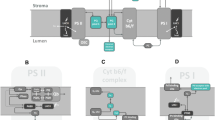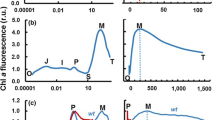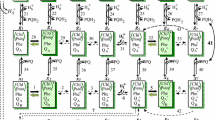Abstract
The set up described in Steffen et al. (Biochemistry 40:173–180, 2001) was used to monitor in the time domain from 100 ns to 10 s single turnover flash-induced transients of the normalized fluorescence yield (SFITFY) on dark-adapted cells of the thermophilic algae Chlorella pyrenoidosa Chick. Perfect data fit was achieved within the framework of a previously proposed model for the PS II reaction pattern (Lebedeva et al., Biophysics 47:968–980, 2002; Belyaeva et al., Biophysics 51:860–872, 2006) after its modification by taking into account nonradiative decay processes including nonphotochemical quenching due to time-dependent populations of P680+• and 3Car. On the basis of data reported in the literature, a consistent set of rate constants was obtained for electron transfer at the donor and acceptor sides of PS II, pH in lumen and stroma, the initial redox state of plastoquinone pool and the rate of plastoquinone oxidation. The evaluation of the rate constant values of dissipative processes due to quenching by carotenoid triplets in antennae and P680+•QA −• recombination as well as the initial state populations after excitation with a single laser flash are close to that outlined in (Steffen et al., Biochemistry 44:3123–3133, 2005a). The simulations based on the model of the PS II reaction pattern provide information on the time courses of population probabilities of different PS II states. We analyzed the maximum (\( F_{\text{m}}^{\text{STF}} \)) and minimum (F 0) of the normalized FL yield dependence on the rate of the recombination processes (radiative and dissipative nonradiative) and of P680+• reduction. The developed PS II model provides a basis for theoretical comparative analyses of time-dependent fluorescence signals, observed at different photosynthetic samples under various conditions (e.g. presence of herbicides, other stress conditions, excitation with actinic pulses of different intensity, and duration).



Similar content being viewed by others
Abbreviations
- Chl:
-
Chlorophyll
- PS II:
-
Photosystem II
- RC:
-
Reaction center of PS II
- P680:
-
Photoactive pigment of the RC of PS II
- Phe:
-
Primary electron acceptor pheophytin
- QA and QB :
-
Primary and secondary quinone electron acceptors of PS II
- 3Car:
-
Triplet carotenoid states
- WOC:
-
Water-oxidizing complex
- PQ:
-
Plastoquinone
- PQH2 :
-
Plastoquinol
- HL + :
-
Protons in lumen
- HS + :
-
Protons in stroma
- YZ :
-
Tyrosine 161 of the PS II D1 polypeptide
- S i :
-
Redox states of the WOC
- ΔΨ:
-
Electric potential across the thylakoid membrane
- ET:
-
Electron transfer
- FL, FL(t):
-
Fluorescence
- k L :
-
Rate constant of light excitation
- \( k_{{{\text{P}}680^{ + } }} ,\;k_{{3_{\text{Car}} }} \) :
-
Rate constants of quenching: by cation radical P680+• by triplet carotenoids
- k F :
-
Rate constant of fluorescence emission
- k HD :
-
Rate constant of heat dissipation of Chl excitation
- k Z :
-
Rate constant of the electron donation to the oxidized P680+•
- k CL :
-
Rate constant of the charge separation for closed RCs
- LED:
-
Light-emitting diode
- SFITFY:
-
Single flash-induced transient of fluorescence yield
- PPFD:
-
Photosynthetic photon flux density
- \( F_{0} ,F_{\text{m}}^{\text{STF}} \) :
-
Minimal maximal FL yield
References
Baake E, Shloeder JP (1992) Modelling the fast fluorescence rise of photosynthesis. Bull Math Biol 54:999–1021
Belyaeva NE (2004) Generalized model of primary photosynthetic processes in chloroplasts. PhD thesis, Moscow
Belyaeva NE, Lebedeva GV, Riznichenko GYu (2003) Kinetic model of primary photosynthetic processes in chloroplasts. Modeling of thylakoid membranes electric potential. In: Riznichenko GYu (ed) Mathematics computer education, vol 10. Progress-Traditsiya, Moscow, pp 263–276
Belyaeva NE, Pashchenko VZ, Renger G, Riznichenko GY, Rubin AB (2006) Application of a photosystem II model for analysis of fluorescence induction curves in the 100 ns to 10 s time domain after excitation with a saturating light pulse. Biophysics 51:860–872
Bernarding J, Eckert HJ, Eichler HJ, Napiwotzki A, Renger G (1994) Kinetic studies on the stabilization of the primary radical pair P680+ Pheo− in different photosystem II preparations from higher plants. Photochem Photobiol 59:566–573
Bergmann A, Eichler HJ, Eckert HJ, Renger G (1998) Picosecond laser-fluorometer with simultaneous time- and wavelength resolution for monitoring decay spectra of photoinhibited photosystem II particles at 277 K and 10 K. Photosynth Res 58:305–312
Brettel K, Schlodder E, Witt HT (1984) Nanosecond reduction kinetics of photooxidized chlorophyll-a II (P–680) in single flashes as a probe for the electron pathway, H+-release and charge accumulation in the O2-evolving complex. Biochim Biophys Acta 766:403–415
Bulychev AA, Vredenberg WJ (1999) Light-triggered electrical events in the thylakoid membrane of plant chloroplast. Physiol Plant 105:577–584
Bulychev AA, Vredenberg WJ (2001) Modulation of photosystem II chlorophyll fluorescence by electrogenic events generated by photosystem I. Bioelectrochemistry 54:157–168
Bulychev AA, Niyazova MM, Rubin AB (1987) Fluorescence changes of chloroplasts caused by the shifts of membrane-potential and their dependence on the redox state of the acceptor of photosystem II. Biolog Membr 4:262–269
Chemeris YuK, Korol’kov NS, Seifullina NKh, Rubin AB (2004) PSII complexes with destabilized primary quinone acceptor of electrons in dark-adapted chlorella. Russ J Plant Physiol 51:9–14
Christen G, Seeliger A, Renger G (1999) P680•+ reduction kinetics and redox transition probability of the water oxidizing complex as a function of pH and H/D isotope exchange in spinach thylakoids. Biochemistry 38:6082–6092
Christen G, Steffen R, Renger G (2000) Delayed fluorescence emitted from light harvesting complex II and photosystem II of higher plants in the 100 ns–5μs time domain. FEBS Lett 475:103–106
Crofts AR, Wraight CA (1983) The electrochemical domain of photosynthesis. Biochim Biophys Acta 726:149–185
Cruz JA, Sacksteder CA, Kanazawa A, Kramer DM (2001) Contribution of electric field (ΔΨ) to steady-state transthylakoid proton motive force (pmf) in vivo and in vitro control of pmf parsing into ΔΨ and ΔpH by ionic strength. Biochemistry 40:1226–1237
Dau H (1994) Short-term adaptation of plants to changing light intensities and its relation to photosystem II photochemistry and fluorescence emission. J Photochem Photobiol B Biol 26:3–27
Dau H, Sauer K (1992) Electric field effect on the picosecond fluorescence of photosystem II and its relation to the energetics and kinetics of primary charge separation. Biochim Biophys Acta 1102:91–106
Eckert H-J, Renger G (1988) Temperature-dependence of P680+ reduction in O2-evolving PS-II membrane-fragments at different redox states Si of the water oxidizing system. FEBS Lett 236:425–431
Gibasiewicz K, Dobek A, Breton J, Leibl W (2001) Modulation of primary radical pair kinetics and energetics in photosystem II by the redox state of the quinone electron acceptor QA. Biophys J 80:1617–1630
Gizzatkulov N, Klimov A, Lebedeva G, Demin O (2004) DBsolve7: new update version to develop and analyze models of complex biological systems. ISMB/ECCB conference, Glasgow, Scotland, UK, 31 July–5 Aug 2004. http://www.insysbio.ru
Goh C-H, Schreiber U, Hedrich R (1999) New approach of monitoring changes in chlorophyll a fluorescence of single guard cells and protoplasts in response to physiological stimuli. Plant Cell Environ 22:1057–1070
Govindjee (ed) (1982) Photosynthesis, vol 2. Academic Press, New York
Hope AB, Huilgol RR, Panizza M, Thompson M, Matthews DB (1992) The flash-induced turnover of cytochrome b-563, cytochrome f and plastocyanin in chloroplasts. Model and estimation of kinetic parameters. Biochim Biophys Acta 1100:15–26
Ireland CR, Long SP, Baker NR (1984) The relationship between carbon dioxide fixation and chlorophyll a fluorescence during induction of photosynthesis in maize leaves at different temperatures and carbon dioxide concentration. Planta 160:550–558
Kamali J, Lebedeva GV, Demin OV, Belyaeva NE, Riznichenko GYu, Rubin AB (2004) Kinetic model of cytochrome bf complex. Fitting of model parameters to experimental data. Biofizika (Russ) 49:1061–1068
Karavaev VA, Kukushkin AK (1993) Theoretical model of light and dark processes of photosynthesis: the problem of regulation. Biophysics 38:987–1003
Kern J, Renger G (2007) Photosystem II: structure and mechanism of the water:plastoquinone oxidoreductase. Photosynth Res 94:183–202
Kühn P, Eckert HJ, Eichler HJ, Renger G (2004) Analysis of the P680+· reduction pattern and its temperature dependence in oxygen evolving PS II core complexes from thermophilic cyanobacteria and higher plants. Phys Chem Chem Phys 6:4838–4843
Laible PD, Zipfel W, Owens TG (1994) Excited state dynamics in chlorophyll-based antennae: the role of transfer equilibrium. Biophys J 66:844–860
Laisk A, Walker DA (1989) A mathematical model of electron transport. Thermodynamic necessity for photosystem II regulation. Proc R Soc Lond B237:417–444
Lavergne J, Trissl HW (1995) Theory of fluorescence induction in photosystem II. Biophys J 68:2474–2492
Lazar D (2003) Chlorophyll a fluorescence rise induced by high light illumination of dark-adapted plant tissue studied by means of a model of photosystem II and considering photosystem II heterogeneity. J Theor Biol 220:469–503
Lazar D (2006) The polyphasic chlorophyll a fluorescence rise measured under high intensity of exciting light. Funct Plant Biol 33:9–30
Lebedeva GV, Belyaeva NE, Riznichenko GYu, Rubin AB, Demin OV (2000) Kinetic model of photosystem II of higher green plants. Russ J Phys Chem 74:1702–1710
Lebedeva GV, Belyaeva NE, Demin OV, Riznichenko GYu, Rubin AB (2002) Kinetic model of primary photosynthetic processes in chloroplasts. Description of the fast phase of chlorophyll fluorescence induction under different light intensities. Biophysics 47:968–980
Leibl W, Breton J, Deprez J, Trissl HW (1989) Photoelectric study on the kinetics of trap** and charge stabilization in oriented PS II membranes. Photosynth Res 22:257–275
Messinger J, Renger G (1993) Generation, oxidation by YD ox and possible electronic configuration of the redox states S0, S−1 and S−2 of the water oxidase in isolated spinach thylakoids. Biochemistry 32:9379–9386
Messinger J, Renger G (2008) Photosynthetic water splitting. In: Renger G (ed) Primary processes of photosynthesis: basic principles and apparatus, vol II: reaction centers/photosystems. Electron transport chains, photophosphorylation and evolution. Royal Society Chemistry, Cambridge, pp 295–352
Neubauer C, Schreiber U (1987) The polyphasic rise of chlorophyll fluorescence upon onset of strong continuous illumination: I. Saturation characteristics and partial control by the photosystem II acceptor side. Z Naturforsch C 42:1246–1254
Papageorgiou GC, Govindjee (2004) Chlorophyll a fluorescence: a signature of photosynthesis. Springer, Berlin
Rappaport F, Cuni A, **ong L, Sayre R, Lavergne J (2005) Charge recombination and thermoluminescence in photosystem II. Biophys J 88:1948–1958
Renger G (2001) Photosynthetic water oxidation to molecular oxygen: apparatus and mechanism. Biochim Biophys Acta 1503:210–228
Renger G, Holzwarth AR (2005) Primary electron transfer. In: Wydrzynski T, Satoh K (eds) Photosystem II: the light driven water:plastoquinone oxidoreductase. Advances in photosynthesis and respiration, vol 22. Springer, Dordrecht, pp 139–175
Renger G, Schulze A (1985) Quantitative analysis of fluorescence induction curves in isolated spinach chloroplasts. Photobiochem Photobiophys 9:79–87
Renger G, Eckert HJ, Bergmann A, Bernarding J, Liu B, Napiwotzki A, Reifarth F, Eichler HJ (1995) Fluorescence and spectroscopic studies on exciton trap** and electron transfer in photosystem II of higher plants. Aust J Plant Physiol 22:167–181
Reynolds IA, Johnson EA, Tanford C (1985) Incorporation of membrane potential into theoretical analysis of electrogenic ion pumps. Proc Natl Acad Sci USA 82:6869–6873
Riznichenko GYu, Lebedeva GV, Demin OV, Rubin AB (1999) Kinetic mechanisms of biological regulation in photosynthetic organisms. J Biol Phys 25:177–192
Roelofs TA, Lee CH, Holzwarth AR (1992) Global target analysis of picosecond chlorophyll fluorescence kinetic from pea chloroplasts. Biophys J 61:1147–1163
Schatz GH, Brock H, Holzwarth AR (1988) Kinetic and energetic model for the primary processes in photosystem II. Biophys J 54:397–405
Schödel R, Irrgang KD, Voigt J, Renger G (1998) Rate of carotenoid triplet formation in solubilized light-harvesting complex II (LHCII) from spinach. Biophys J 75:3143–3153
Schödel R, Irrgang KD, Voigt J, Renger G (1999) Quenching of chlorophyll fluorescence by triplets in solubilized light-harvesting complex II (LHCII). Biophys J 76:2238–2248
Schreiber U, Krieger A (1996) Two fundamentally different types of variable chlorophyll fluorescence in vivo. FEBS Lett 397:131–135
Schreiber U, Schliwa U, Bilger W (1986) Continuous recording of photochemical and nonphotochemical fluorescence quenching with a new type of modulation fluorometre. Photosynth Res 10:51–62
Shuvalov VA, Klimov VV, Dolan E, Parson WW, Ke B (1980) Nanosecond fluorescence and absorbance changes in photosystem II at low redox potential. FEBS Lett 118:279–282
Steffen R (2003) Time-resolved spectroscopic investigations of photosystem II. PhD thesis, Berlin
Steffen R, Christen G, Renger G (2001) Time-resolved monitoring of flash-induced changes of fluorescence quantum yield and decay of delayed light emission in oxygen-evolving photosynthetic organisms. Biochemistry 40:173–180
Steffen R, Eckert HJ, Kelly AA, Dormann P, Renger G (2005a) Investigations on the reaction pattern of photosystem II in leaves from Arabidopsis thaliana by time-resolved fluorometric analysis. Biochemistry 44:3123–3133
Steffen R, Kelly AA, Huyer J, Doermann P, Renger G (2005b) Investigations on the reaction pattern of photosystem II in leaves from Arabidopsis thaliana wild type plants and mutants with genetically modified lipid content. Biochemistry 44:3134–3142
Stirbet A, Govindjee , Strasser BJ, Strasser RJ (1998) Chlorophyll a fluorescence induction in higher plants: modeling and numerical simulation. J Theor Biol 193:131–151
Strasser RJ, Srivastava A, Govindgee (1995) Polyphasic chlorophyll a fluorescence transient in plants and cyanobacteria. Photochem Photobiol 61:32–42
Strasser RJ, Tsimilli-Michael M, Srivastava A (2004) Analysis of the chlorophyll a fluorescence transient. In: Papageorgiou GC, Govindjee (eds) Chlorophyll fluorescence: a signature of photosynthesis. Advances in photosynthesis and respiration, vol 19. Kluwer Academic Publishers, The Netherlands, pp 321–362
Toth SZ, Schansker G, Strasser RJ (2005) In intact leaves, the maximum fluorescence level (FM) is independent of the redox state of the plastoquinone pool: a DCMU inhibition study. Biochim Biophys Acta 1708:275–282
van Kooten O, Snel JFH, Vredenberg WJ (1986) Free energy transduction related to the electric potential changes across the thylakoid membrane. Photosynth Res 9:211–227
Vasil’ev S, Bergmann A, Redlin H, Eichler HJ, Renger G (1996) On the role of exchangeable hydrogen bonds for the kinetics of P680+QA − formation and P680+Pheo− recombination in photosystem II. Biochim Biophys Acta 1276:35–44
Vermaas WCJ, Renger G, Dohnt G (1984) The reduction of the oxygen-evolving system in chloroplasts by thylakoid components. Biochim Biophys Acta 764:194–202
Vredenberg WJ (2000) A 3-state model for energy trap** and fluorescence in PS II incorporating radical pair recombination. Biophys J 79:26–38
Vredenberg WJ, Bulychev AA (2003) Photoelectric effects on chlorophyll fluorescence of photosystem II in vivo. Kinetic in the absence and presence of valinomycin. Bioelectrochemistry 60:87–95
Zhu XG, Govindjee , Baker NR, deSturler E, Ort DR, Long SP (2005) Chlorophyll a fluorescence induction kinetics in leaves predicted from a model describing each discrete step of excitation energy and electron transfer associated with photosystem II. Planta 223:114–133
Acknowledgments
We are grateful to Prof. A. A. Bulychev for the fruitful discussions, Dr. O. V. Demin for DBsolve software: version 7.01 (demin@genebee.msu.su). This work was supported by the Russian Foundation for Basic Research, project nos. 07-04-00375, 05-04-48912, 08-04-01112, by the International Bureau of BMBF, Germany, project RUS 06/003, and by Deutsche Forschungsgemeinschaft (SfB 429).
Author information
Authors and Affiliations
Corresponding author
Rights and permissions
About this article
Cite this article
Belyaeva, N.E., Schmitt, FJ., Steffen, R. et al. PS II model-based simulations of single turnover flash-induced transients of fluorescence yield monitored within the time domain of 100 ns–10 s on dark-adapted Chlorella pyrenoidosa cells. Photosynth Res 98, 105–119 (2008). https://doi.org/10.1007/s11120-008-9374-2
Received:
Accepted:
Published:
Issue Date:
DOI: https://doi.org/10.1007/s11120-008-9374-2




